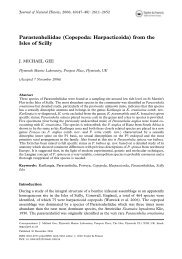An Updated Classification of the Recent Crustacea
An Updated Classification of the Recent Crustacea
An Updated Classification of the Recent Crustacea
You also want an ePaper? Increase the reach of your titles
YUMPU automatically turns print PDFs into web optimized ePapers that Google loves.
Boxshall and Jaume (2000, see also 1999). The palpophriids<br />
and misophriids constitute a clade that is<br />
<strong>the</strong> sister group to <strong>the</strong> Speleophriidae (Boxshall and<br />
Jaume, 1999).<br />
ORDER CYCLOPOIDA<br />
Papers with new cyclopoid taxa include Boxshall<br />
(1988; Chordeumiidae), Ho and Thatcher (1989;<br />
Ozmanidae [<strong>of</strong> interest because this family is based<br />
on a new genus and species from a freshwater snail,<br />
making it, according to <strong>the</strong> authors, <strong>the</strong> ‘‘first parasitic<br />
copepod ever recorded from a freshwater invertebrate’’]),<br />
da Rocha and Iliffe (1991; Speleoithonidae),<br />
and Ho et al. (1998; Fratiidae). The<br />
family Thespesiopsyllidae has been removed, as it<br />
is an objective synonym <strong>of</strong> Thaumatopsyllidae (see<br />
McKinnon, 1994). The family Mantridae, originally<br />
placed in <strong>the</strong> Poecilostomatoida, was transferred<br />
to <strong>the</strong> Cyclopoida by Huys (1990d).<br />
We initially removed from <strong>the</strong> cyclopoids <strong>the</strong> Botrylophyllidae<br />
and Buproridae, following Huys and<br />
Boxshall (1991). Illg and Dudley (1980) recognized<br />
<strong>the</strong>se as subfamilies <strong>of</strong> <strong>the</strong> Ascidicolidae (along<br />
with five o<strong>the</strong>r subfamilies), and Huys and Boxshall<br />
(1991) followed that arrangement. However, Huys<br />
(pers. comm.) has suggested that <strong>the</strong> Buproridae<br />
(and also <strong>the</strong> Botrylophyllidae; see below) should<br />
be reinstated. G. Boxshall (pers. comm.) also feels<br />
that <strong>the</strong> Ascidicolidae, as constituted, ‘‘is too heterogeneous<br />
and <strong>the</strong> Buproridae at least should be<br />
accorded separate family status.’’ However, <strong>the</strong> situation<br />
with <strong>the</strong> Botrylophyllidae is more problematic,<br />
one problem being that it is a junior synonym<br />
<strong>of</strong> <strong>the</strong> Schizoproctidae (Illg and Dudley, 1980; G.<br />
Boxshall, pers. comm.); Boxshall (pers. comm.)<br />
feels that most, but not all, <strong>of</strong> <strong>the</strong> seven ascidicolid<br />
subfamilies recognized by Illg and Dudley (1980)<br />
‘‘will eventually be given full family status.’’ Thus,<br />
we have reinstated <strong>the</strong> Buproridae but not <strong>the</strong> Botrylophyllidae.<br />
The former families Enterocolidae,<br />
Enteropsidae, and Schizoproctidae were also reduced<br />
to subfamilies <strong>of</strong> <strong>the</strong> Ascidicolidae by Illg<br />
and Dudley (1980), according to J.-S. Ho (pers.<br />
comm.). The family Cucumaricolidae was transferred<br />
here from <strong>the</strong> Poecilostomatoidea following<br />
Huys and Boxshall (1991), among o<strong>the</strong>r such<br />
changes (see <strong>the</strong>ir book). O<strong>the</strong>r changes to <strong>the</strong><br />
Bowman and Abele (1982) list include <strong>the</strong> removal<br />
<strong>of</strong> <strong>the</strong> Doropygidae (long known to be a synonym<br />
<strong>of</strong> <strong>the</strong> Notodelphyidae) and <strong>the</strong> Namakosiramiidae<br />
(a synonym <strong>of</strong> <strong>the</strong> harpacticoid family Laophontidae)<br />
(J.-S. Ho, pers. comm.; G. Boxshall, pers.<br />
comm.). Ho (1994b) discussed cyclopoid phylogeny<br />
(based on cladistic analysis <strong>of</strong> <strong>the</strong> 10 families<br />
known at that time) and concluded that parasitism<br />
had arisen twice in <strong>the</strong> group.<br />
ORDERS GELYELLOIDA AND<br />
MORMONILLOIDA<br />
The order Gelyelloida was established by Huys<br />
(1988) for <strong>the</strong> family Gelyellidae, treated in <strong>the</strong> past<br />
as a harpacticoid family and listed as ‘‘infraorder<br />
incertae cedis’’ by Bowman and Abele (1982:11).<br />
The Mormonilloida is unchanged, consisting still <strong>of</strong><br />
<strong>the</strong> single family Mormonillidae.<br />
ORDER HARPACTICOIDA<br />
Papers describing new harpacticoid taxa (or elevating<br />
former subfamilies) include Huys (1990a, Adenopleurellidae;<br />
1990b, Hamondiidae, Ambunguipedidae;<br />
1990c, Cristacoxidae, Orthopsyllidae),<br />
Por (1986, Argestidae, Huntemanniidae, Paranannopidae<br />
[revised by Huys and Gee, 1996], Rhizothricidae<br />
[splitting <strong>the</strong> polyphyletic Cletodidae]),<br />
Fiers (1990, Cancrincolidae), Huys and Willems<br />
(1989, Laophontopsidae, Normanellidae; see also<br />
Huys and Lee, 1999), Huys and Iliffe (1998, Novocriniidae),<br />
Huys (1988, Rotundiclipeidae), Huys<br />
(1993, Styracothoracidae), and Huys (1997, Superornatiremidae).<br />
Huys and Lee (1999) elevated to<br />
family level <strong>the</strong> Cletopsyllinae, formerly a subfamily<br />
<strong>of</strong> <strong>the</strong> Normanellidae (following Huys and Willems,<br />
1989). The Paranannopidae established by<br />
Por (1986) was relegated to a subfamily <strong>of</strong> <strong>the</strong><br />
Pseudotachidiidae by Willen (1999); <strong>the</strong> Pseudotachidiidae<br />
was formerly a subfamily <strong>of</strong> <strong>the</strong> Thalestriidae.<br />
Huys et al. (1996) referred to this assemblage<br />
(<strong>the</strong> Paranannopidae) as <strong>the</strong> Danielsseniidae<br />
Huys and Gee because Paranannopidae was based<br />
on an unavailable genus name. Thus, <strong>the</strong> family<br />
Paranannopidae ( <strong>the</strong> Danielsseniidae <strong>of</strong> Huys et<br />
al., 1996) does not appear in our list, as it is considered<br />
a subfamily <strong>of</strong> <strong>the</strong> Pseudotachiidae following<br />
Willen’s (1999) preliminary study. The subfamily<br />
Leptastacinae Lang was upgraded to a family by<br />
Huys (1992). The family Gelyellidae, treated by<br />
Bowman and Abele (1982) as a harpacticoid family,<br />
was transferred to its own order, Gelyelloida,<br />
by Huys (1988). Relationships among <strong>the</strong> laophontoidean<br />
families were addressed by Huys (1990b)<br />
and Huys and Lee (1999).<br />
Arbizu and Moura (1994) found <strong>the</strong> family Cylindropsyllidae<br />
polyphyletic and elevated <strong>the</strong> former<br />
subfamily Leptopontiinae to family level (family<br />
Leptopontiidae). Although <strong>the</strong>y also suggested<br />
that <strong>the</strong> family Cylindropsyllidae should be relegated<br />
to a subfamily <strong>of</strong> <strong>the</strong> Canthocamptidae, we<br />
have retained <strong>the</strong> family Cylindropsyllidae for now<br />
(and on <strong>the</strong> advice <strong>of</strong> R. Huys, pers. comm.).<br />
ORDER POECILOSTOMATOIDA<br />
Papers describing new poecilostomatoid taxa include<br />
Humes (1986, <strong>An</strong><strong>the</strong>ssiidae), Humes and<br />
Boxshall (1996, <strong>An</strong>chimolgidae, Kelleriidae, Macrochironidae,<br />
Octopicolidae, Synapticolidae,<br />
Thamnomolgidae), Avdeev and Sirenko (1991, Chitonophilidae<br />
[incomplete description; tentative<br />
placement in <strong>the</strong> Poecilostomatoida is based on<br />
pers. comm. from W. Vervoort, A. Humes, and G.<br />
Boxshall]), Ho (1984, Entobiidae, Spiophanicolidae),<br />
Humes (1987, Erebonasteridae), Marchenkov<br />
and Boxshall (1995, Intramolgidae), Huys and<br />
Contributions in Science, Number 39 Rationale 27











